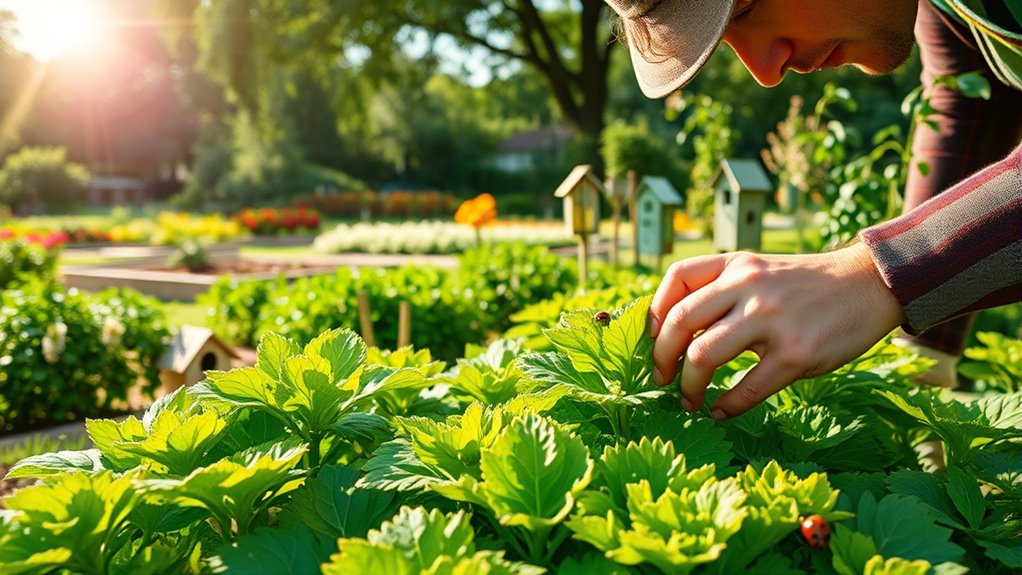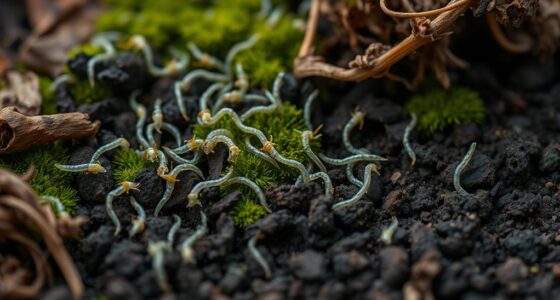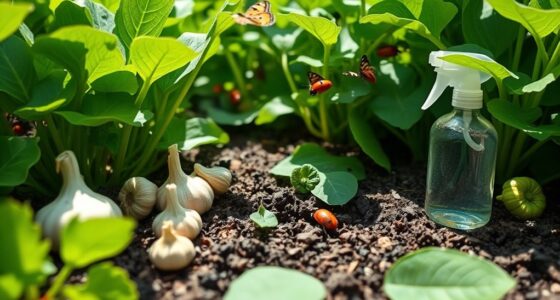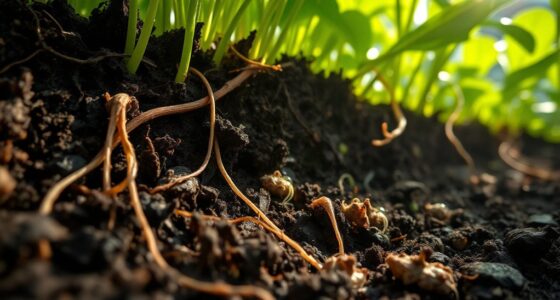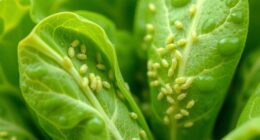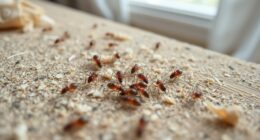Integrated Pest Management (IPM) is a smart way to control pests in your garden by combining different strategies. It emphasizes understanding pest behavior, monitoring pests regularly, and using targeted methods like beneficial insects, physical barriers, and organic sprays. Chemical pesticides are a last resort. This approach helps protect your plants, beneficial insects, and the environment. Keep exploring to discover effective, eco-friendly pest control techniques that suit your garden’s needs.
Key Takeaways
- IPM combines multiple pest control strategies to minimize environmental and health impacts.
- It emphasizes monitoring pest populations and understanding pest behavior for targeted action.
- Beneficial insects and organic methods are used to control pests naturally, reducing chemical reliance.
- Physical barriers and organic sprays serve as alternatives to chemical pesticides in IPM.
- The goal is sustainable, effective pest management that protects plants, beneficial insects, and the environment.

If you’re looking for an effective way to keep pests under control in your garden, integrated pest management (IPM) offers a smart and eco-friendly solution. IPM combines various strategies to manage pest populations while minimizing harm to your plants, beneficial insects, and the environment. Instead of relying solely on chemical pesticides, IPM emphasizes understanding pest behavior, monitoring their presence, and using targeted interventions. This approach reduces pesticide use and promotes a healthier garden ecosystem.
Effective pest control with IPM combines strategies to protect your garden naturally and sustainably.
One of the key components of IPM is encouraging beneficial insects. These natural predators, such as ladybugs, lacewings, and predatory beetles, help control pest populations naturally. By creating a habitat that attracts and sustains these beneficial insects, you can considerably reduce pest numbers without resorting to harsh chemicals. Planting nectar-rich flowers or providing shelter areas can support their presence in your garden. This strategy not only helps keep pests in check but also enhances the overall biodiversity of your garden, leading to a more resilient and balanced ecosystem.
Pesticide alternatives are another vital aspect of IPM. Instead of immediately reaching for chemical sprays, you explore options like biological controls, physical barriers, or organic sprays that target pests specifically. For example, introducing beneficial insects or applying neem oil can suppress pest populations effectively without harming non-target organisms. Mechanical methods, such as handpicking or using row covers, also play a role in preventing pest access to your plants. These alternatives are often safer for you, your family, and the environment, making them a sustainable choice for long-term pest management.
Monitoring is fundamental to IPM because it helps you decide when and how to intervene. Regularly inspecting your plants for signs of pests or damage allows you to catch problems early, preventing them from escalating. This targeted approach means you only treat when necessary, reducing unnecessary pesticide use. When pests do become problematic, you prioritize least-toxic solutions first, reserving chemical controls as a last resort. Additionally, understanding portable camping toilets and other outdoor gear options can make garden work more comfortable and accessible, especially in remote or outdoor settings. This strategy guarantees that your pest management efforts are both effective and environmentally responsible.
Frequently Asked Questions
How Does IPM Compare to Traditional Pesticide Use?
Compared to traditional pesticide use, IPM is more sustainable because it minimizes chemical reliance and emphasizes natural pest controls. You actively monitor pest levels and use targeted methods, reducing environmental impact and protecting beneficial insects. This approach promotes healthier gardens and ecosystems, unlike conventional pesticides that can harm the environment and lead to resistant pests. By adopting IPM, you support environmentally friendly practices while effectively managing pests.
Can IPM Be Effective for Large-Scale Commercial Farms?
You can definitely make IPM effective for large-scale commercial farms. By implementing sustainable farming practices, you reduce reliance on chemical pesticides and promote healthier ecosystems. Pest monitoring plays a vital role, helping you identify issues early and target pests precisely. With proper planning and consistent monitoring, IPM becomes a practical, efficient approach to managing pests at a commercial level, benefiting both your crop yields and the environment.
What Are Common Mistakes to Avoid in Implementing IPM?
When implementing IPM, avoid common mistakes like pest misidentification, which can lead to ineffective controls. Don’t rely solely on chemicals, as this can harm beneficial insects and cause resistance. Instead, combine cultural, biological, and mechanical methods for better results. Regular monitoring and accurate identification are key. Stay informed and adapt your strategies to guarantee your pest management is sustainable and effective, reducing unnecessary chemical use.
Are There Specific Tools or Technology Used in IPM?
You’ll find monitoring tools essential in IPM, helping you track pest populations and assess damage. These include traps, pheromone lures, and visual inspections. Biological controls, like beneficial insects, are also key tools that naturally reduce pests. By using these technologies, you can make informed decisions, applying interventions only when necessary, and minimizing chemical use to protect your garden’s health and sustainability.
How Long Does It Typically Take to See Results With IPM?
You might wonder how long it takes to see results with IPM. Typically, you can expect visible changes within a few weeks, depending on the pest problem and your approach. IPM focuses on timing expectations, so patience is key. You’ll notice pest populations decrease gradually as you implement targeted, eco-friendly methods. Consistent monitoring and adjustments help guarantee effective control, leading to healthier plants and a balanced garden ecosystem over time.
Conclusion
By adopting integrated pest management, you’re reducing chemical use by up to 50%, making your garden safer for pollinators and your family. This sustainable approach not only keeps pests in check but also promotes healthy, thriving plants. Remember, a study shows that gardens practicing IPM experience 30% fewer pest outbreaks over time. So, embrace IPM techniques, and watch your garden flourish naturally while protecting the environment around you.
